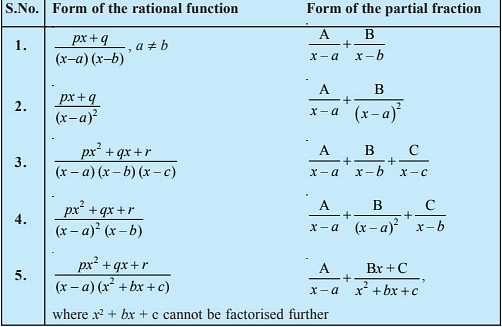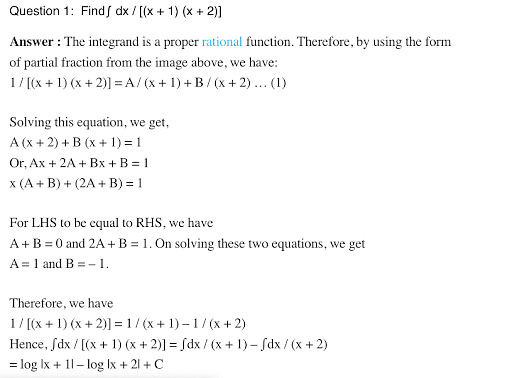Question:
What is the area of a loop of the curve $r = a \sin^3 \theta$ ?
What is the area of a loop of the curve $r = a \sin^3 \theta$ ?
Updated On: Aug 22, 2024
- $\frac{\pi a^2}{6} $
- $\frac{\pi a^2}{8} $
- $\frac{\pi a^2}{12} $
- $\frac{\pi a^2}{24} $
Hide Solution
Verified By Collegedunia
The Correct Option is D
Solution and Explanation
If curve $r = a \sin \, 3\theta$
To trace the curve, we consider the following table :
Thus there is a loop between $\theta = 0 $ & $\theta = \frac{\pi}{3}$ as r varies from $r = 0$ to $r = 0$.
Hence, the area of the loop lying in the positive quadrant $= \frac{1}{2} \int^{\frac{\pi}{3}}_{0} r^{2} d \theta $
$ = \frac{1}{2} \int ^{\frac{\pi }{3}}_{0}\sin^{2} \phi . \frac{1}{3} d\phi $
[On putting, $3\theta = \phi \Rightarrow d\theta = \frac{1}{3} d\phi$]
$ = \frac{a^{2}}{6} \int ^{\frac{\pi }{2}}_{0} \sin^{2} \phi d\phi $
$= \frac{a^{2}}{6}. \int^{\frac{\pi}{2}}_{0} \frac{1 - \cos 2\phi}{2} d\phi \left[ \because \, \, \cos 2\theta = 1 - 2 \sin^{2} \theta\right]$
$ = \frac{a^{2}}{12} . \left[\phi + \frac{\sin 2 \phi}{2}\right]^{\frac{\pi}{2}}_{0}$
$ = \frac{a^{2}}{12}. \left[ \frac{\pi}{2} + \sin \pi\right] = \frac{a^{2} \pi}{24}$
Was this answer helpful?
2
1
Top Questions on Integration by Partial Fractions
- The value of \(\frac {120}{\pi^3}|∫_0^\pi\frac {x^2sinx.cosx}{(sinx)^4+(cosx)^4}dx|\) is
- JEE Main - 2024
- Mathematics
- Integration by Partial Fractions
- The integral \[ \int \frac{x^8 - x^2}{(x^{12} + 3x^6 + 1) \tan^{-1}\left( \frac{x^3 + 1}{x^3} \right)} \, dx \] is equal to:
- JEE Main - 2024
- Mathematics
- Integration by Partial Fractions
- \(\text{Evaluate } \int e^x \left( \frac{2x + 1}{2 \sqrt{x}} \right) dx:\)
- CUET (UG) - 2024
- Mathematics
- Integration by Partial Fractions
- Evaluate the integral $\int \frac{\pi}{x^n + 1 - x} , dx$:
- CUET (UG) - 2024
- Mathematics
- Integration by Partial Fractions
- $\displaystyle\sum_{k=0}^6{ }^{51-k} C_3$ is equal to
- JEE Main - 2023
- Mathematics
- Integration by Partial Fractions
View More Questions
Questions Asked in VITEEE exam
- Two identical blocks A and B, each of mass 'm' resting on a smooth floor are connected by a light spring of natural length L and spring constant K, with the spring at its natural length. A third identical block 'C' (mass m) moving with a speed v along the line joining A and B collides with A. the maximum compression in the spring is
- VITEEE - 2023
- work, energy and power
- Assertion :
The binding energy of the nucleus increases with the increase in atomic number.
Reason :
Heavier elements have a greater number of non-radioactive isotopes than radioactive isotopes. - The half-life of radioactive radon is 3.8 days. The time at the end of which \(\frac{1}{20}th\) of the Radon sample will remain undecayed is (given log10e=0.4343)
- Which element has more electron gain enthalpy among chalcogen group?
- VITEEE - 2022
- sulphur
- Coin is tossed till heads is obtained what is expectation of no. of coin tosses
- VITEEE - 2022
- Random Variables
View More Questions
Concepts Used:
Integration by Partial Fractions
The number of formulas used to decompose the given improper rational functions is given below. By using the given expressions, we can quickly write the integrand as a sum of proper rational functions.

For examples,




